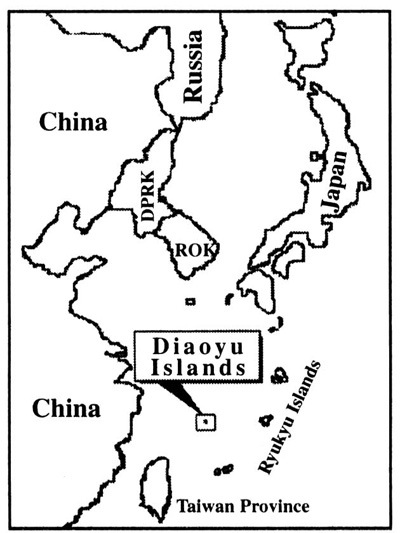 |
|
(BEIJING REVIEW NO. 39, 1996) |
The Diaoyu Islands, in the East China Sea between China and Japan, have belonged to China since ancient times. The islands include some small islands and reefs, with the Diaoyu Island the largest one covering an area of five square kilometers. No one can live there due to the lack of fresh water.
The islands are 120 nautical miles northeast of Taiwan, 200 nautical miles east of China's mainland and 200 nautical miles west of Japan's southernmost island Okinawa.
Geologically the islands are attached to Taiwan. The waters around the islands are 100 to 150 meters deep and there is a 2,000-meter deep oceanic trench between the islands and Japan's Okinawa islands.
Fishermen from China's Taiwan and Fujian and other provinces have fished and collected herbs in the area for centuries.
The islands are recorded in a book published during the rule of Emperor Yong Le (1403-1424) in the Ming Dynasty (1368-1644), more than 400 years before Japan claimed discovery of the Diaoyu Islands in 1884. Since then many Chinese historical documents refer to the islands.
In the 15th century during the Ming Dynasty, China included the Diaoyu Islands into its coastal defense area.
In 1556, General Hu Zongxian was appointed governor to fight Japanese pirates and defend the coastal area, including the Diaoyu Islands.
A map published in Japan between 1783 and 1785 marking the boundary of the Ryukyu Kingdom showed the Diaoyu Islands as belonging to China.
Japan never questioned China's sovereignty over the islands before the Sino-Japanese War of 1894-1895. In April 1895, the government of the Qing Dynasty (1644-1911) was forced to sign the Treaty of Shimonoseki, under which China ceded the whole island of Taiwan and its surrounding islands including the Penghu Islands to Japan.
Only since then has Japan had its own name for the area where the Diaoyu Islands are located. Before that, Japanese maps marked the islands by their Chinese names. Japan was occupied by the United States after it was defeated in World War II.
In 1951, Japan and the United States illegally signed a treaty in San Francisco without the presence of China, one of the victorious countries in World War II.
Although Article 2 of the treaty said that Japan surrendered its claim over Taiwan and the Penghu Islands to China, Article 3 wrongly assigned the Diaoyu Islands, which Japan had stolen from China, and other islands, to the Ryukyu zone which was under U.S. control.
The then Chinese Premier Zhou Enlai lodged a strong protest and said the Chinese government would never recognize the San Francisco Treaty.
In a statement on territorial waters in 1958, the Chinese government said that Japan should return all the territory of the People's Republic of China including Taiwan and the islands around it to China.
On November 11, 1969, Japan and the United States signed an agreement to return the Okinawan Islands to Japan.
In 1971, the United States, proceeding from its Cold War policy against China, returned the area under its trusteeship, including the Diaoyu Islands, to Japan.
The Japanese Government thereby regarded the islands as a part of its Okinawa-Ken Prefecture and included them in the "air defense distinguishing rim" of its Self-Defense Forces.
On this situation, the Chinese Government issued a solemn statement on December 30, 1971, announcing that the Diaoyu islands are islands attached to Taiwan and like Taiwan, have always been an alienable part of Chinese territory since ancient times.
Consequently, it is an indisputable fact that the Diaoyu Islands have historically been a part of China's territory.
The issue of the Diaoyu Islands once served as an obstacle to the normalization of Sino-Japanese relations and the conclusion of the Sino-Japanese Treaty of Peace and Friendship. Taking into consideration the overall interest to develop Sino-Japanese friendship, the then Chinese and Japanese governments agreed to settle the issue in the future.
However, the Japanese side has broken its promises repeatedly and has provoked incidents one after another in recent years in an attempt to seize the islands.
In the 1990s, various Japanese right wing activists visited the Islands, and Japan has encouraged these visits, despite protests by the Chinese government.
In September 2010, the dispute over Diaoyu Islands escalated after a Japanese patrol ship clashed with a Chinese fishing boat. Japan's defence ministry published a defence plan, outlining measures to defend the islands.
In November 2011, Japan held its largest military exercise since World War Two off Kyushu Island. simulating possible attacks from China
In 2012, Japan raised tensions further after government officials made visits to the islands, gave official Japanese names to the islets and the Governor of Tokyo announced plans to "buy" them from the island's private owners. Japan's Prime Minister Yoshihiko Noda says he's considering "nationalizing" part of the islands.
(Complied from Beijing Review NO. 39, 1996 and CNTV.cn) | 